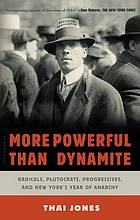
More Powerful Than Dynamite
Radicals, Plutocrats, Progressives, and New York's Year of Anarchy
کتاب های مرتبط
- اطلاعات
- نقد و بررسی
- دیدگاه کاربران
نقد و بررسی

February 13, 2012
With tensions brewing in Europe at the start of “the first war to end all wars” in 1914, New York City was rife with continuing conflict between the haves and have-nots, shaping the future of national politics and culture, according to this atmospheric account. Jones, a former Newsday reporter, details the young, patrician, and anti-Tammany Hall mayor, John Purroy Mitchel, who tried to keep the lid on a metropolis being pulled apart by anarchists and unionists attempting to bring down industrialist John D. Rockefeller and his fellow plutocrats, while they also tried to maintain labor rights on the front burner. This pivotal year has its share of political promises, rebel-rousing rhetoric, and bloodshed, including the activitiets of anarchists Emma Goldman and Alexander Berkman, journalists Walter Lippman and Upton Sinclair, and dedicated radicals Frank Tannenbaum and Becky Edelsohn (reputedly America’s first hunger striker). Delving into the major players behind the dramatic events of 1914 in New York City, Jones (A Radical Line) draws parallels between 1914 and recent times in the social issues, moral dilemmas, and lack of political insight with intelligent research, fascinating characters, and striking tabloid color. B&w illus. Agent: Anna Ghosh, Scovil, Galen, Ghosh Literary Agency.

March 1, 2012
A messy conglomeration of personalities make up this ill-focused yet engaging portrait of New York City on the verge of anarchy and war, 1914. Chockablock with research and detail, journalist Jones' second work (after A Radical Line: From the Labor Movement to the Weather Underground, One Family's Century of Conscience, 2004) includes everything except a clear thesis. If there is anything he is proving, it is his passion and respect for the players of that roiling, revolutionary time: anarchists like Emma Goldman and Alexander Beckman, reform-minded New York City mayor-elect John Purroy Mitchel, crusading journalists like Mother Jones and Uptown Sinclair and even the Christian idealist out of step with his plutocratic patriarch, John D. Rockefeller Jr. Jones moves chronologically throughout 1914, which opened after the relative harmony of the previous year. However, social evils in all facets of society were exposed by enlightened provocateurs like the young unemployed labor leader Frank Tannenbaum, who led fellow groups of unemployed into the city's churches for shelter during that extremely harsh winter and was eventually arrested. Anarchists were on the march as well, supported by union protestors, often to violent effect; they taxed the resources and good will of the new mayor and his broad-minded new police commissioner, Arthur Woods. Employees at the Colorado Fuel & Iron Company, co-owned by Rockefeller but managed from a distance, went on strike, culminating in the so-called Ludlow Massacre, which prompted a sea change in Rockefeller Jr.'s antiquated views on collective organization and union rights. President Wilson struggled with turmoil in Mexico, calls for war in Europe and his own health, while a bomb probably designated for Rockefeller Jr. detonated accidentally in a Lexington Avenue apartment, killing three anarchists. Jones provides deep research and nicely fleshed portraits but only partial synthesis of the information.
COPYRIGHT(2012) Kirkus Reviews, ALL RIGHTS RESERVED.

February 15, 2012
Soapboxes, raucous parades, hunger strikes, and dynamite. These tactics were among the methods of American protest in the early 1900s, and New York City was the epicenter. The titular year of anarchy for Jones (former reporter, New York Newsday; A Radical Line: From the Labor Movement to the Weather Underground, One Family's Century of Conscience) is 1914. Through the tensions between a circle of passionate radicals and John D. Rockefeller Jr., Jones examines the larger picture. Tensions exploded--sometimes literally--partially fueled by the Ludlow massacre of miners' families, killed by troops confronting strikers from the Rockefeller-owned Colorado Fuel & Iron Company. Jones discusses well-known radical favorites, e.g., Emma Goldman, as well as activists less familiar to a modern audience, among them Frank Tannenbaum, Arthur Caron, and Becky Edelsohn. He treats all with dignity, examining their motives and character and spinning a human story around historical events, a presentation that one would expect from a former journalist. VERDICT This book compares favorably with other works on 20th-century radicalism. Recommended for undergraduates and casual readers interested in the history of American labor and social-justice movements.--Laura Ruttum Senturia, Univ. of Colorado-Boulder Lib.
Copyright 2012 Library Journal, LLC Used with permission.

























دیدگاه کاربران